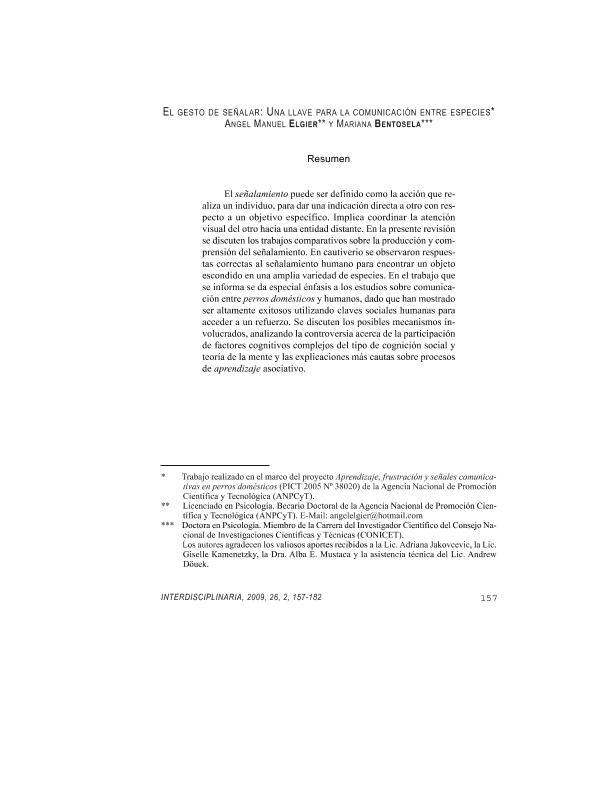Artículo
El señalamiento puede ser definido como la acción que realiza un individuo, para dar una indicación directa a otro con respecto a un objetivo específico. Implica coordinar la atención visual del otro hacia una entidad distante. En la presente revisión se discuten los trabajos comparativos sobre la producción y comprensión del señalamiento. En cautiverio se observaron respuestas correctas al señalamiento humano para encontrar un objeto escondido en una amplia variedad de especies. En el trabajo que se informa se da especial énfasis a los estudios sobre comunicación entre perros domésticos y humanos, dado que han mostrado ser altamente exitosos utilizando claves sociales humanas para acceder a un refuerzo. Se discuten los posibles mecanismos involucrados, analizando la controversia acerca de la participación de factores cognitivos complejos del tipo de cognición social y teoría de la mente y las explicaciones más cautas sobre procesos de aprendizaje asociativo. Communication between two animals takes place when an external observer can detect changes in the behavior of one of them, in response to certain signs emitted by the other one. The pointing gesture is a key element inside gestural communication. It can be defined as the action that an organism executes, to give a direct indication to other one, regarding a specific objective. This gesture is related to how an organism coordinates the visual attention of another one towards a distant entity. It has two principal functions: as declarative gesture, it implies an action that directs the attention of the receiver to an object or event of interest; as imperative gesture, some type of action is required from the receiver. In this paper, some studies focused on the production and, most of them, on the comprehension of pointing are discussed. Regarding the production of communicative cues, primates rarely point in their natural habitats, but captive chimpanzees usually point food out of their reach. There are few studies of communicative production in domestic dogs, and their focus is on the applied value of this ability as in hunting or rescue. This species use body posture, barks and gaze alternation (showing) as communicative cues. On the other hand, the most common test to evaluate whether animals can understand declarative gestures is the object-choice task, which forces subjects to use an indicatory gesture in order to find hidden food. In this test, the subject is given a choice between two possible food locations, usually opaque containers. The experimenter hides food in one of the containers and gives a cue (e.g. pointing, gazing, tapping, etc.) towards the aim container. The subject can choose one of the potential locations, following the human cue. Using pointing as a cue in situations of captivity, correct responses were observed in a wide variety of species including capuchin monkeys, orangutans, gorillas, chimpanzees, dolphins, domestic goats, cats, horses, seals and fur seals. In this paper we give special emphasis to the studies with domestic dogs, because they have shown to be especially skilful at the communicative version of the object choice task. The dogs are very skilful using a variety of cues, including pointing, looking, and bowing towards the object. Moreover, this successful performance takes place from the first trials and from early stages of development, without needing an explicit training. Regarding the elements of pointing gesture, a study has shown that an elevated arm position was the most relevant element in the composition of this signal, whereas the direction of the movement of the arm played a small relevance in the indication of the direction for the dog. The hand or the index fingers seem to be of special importance, while the arm and elbow were not effective signs. Furthermore, in some cases the dogs favour the social information even if there are physical cues that contradict it, such as visual or olfatory cues. We present comparative studies between domestic dogs and other species, including other canids like wolves and foxes, primates and cats. The superior performance of the dogs is analyzed. Finally, the possible mechanisms involved in this ability are discussed, analyzing the controversy between cognitive complex factors, such as social cognition and theory of mind (high level explanation), and more cautious explanations, such as associative learning processes (low level explanation). The relevance of these studies about communication is revealed in the great quantity of applied areas in which dogs are used, such as assistance to disabled persons, search and rescue of people, hunting, herding, defense, pets and others fields.
El gesto de señalar: una llave para la comunicación entre especies
Título:
Pointing gesture: A key for communication between species
Fecha de publicación:
12/2009
Editorial:
Consejo Nacional de Investigaciones Científicas y Técnicas. Centro Interamericano de Investigaciones Psicológicas y Ciencias Afines; Consejo Nacional de Investigaciones Científicas y Técnicas. Centro Interdisciplinario de Investigaciones en Psicología Matemática y Experimental
Revista:
Interdisciplinaria
ISSN:
0325-8203
e-ISSN:
1668-7027
Idioma:
Español
Tipo de recurso:
Artículo publicado
Clasificación temática:
Resumen
Palabras clave:
Señalamiento
,
Comunicación interespecífica
,
Perros domésticos
,
Aprendizaje
Archivos asociados
Licencia
Identificadores
Colecciones
Articulos(IDIM)
Articulos de INST.DE INVEST.MEDICAS
Articulos de INST.DE INVEST.MEDICAS
Citación
Elgier, Angel Manuel; Bentosela, Mariana; El gesto de señalar: una llave para la comunicación entre especies; Consejo Nacional de Investigaciones Científicas y Técnicas. Centro Interamericano de Investigaciones Psicológicas y Ciencias Afines; Consejo Nacional de Investigaciones Científicas y Técnicas. Centro Interdisciplinario de Investigaciones en Psicología Matemática y Experimental; Interdisciplinaria; 26; 2; 12-2009; 157-182
Compartir




